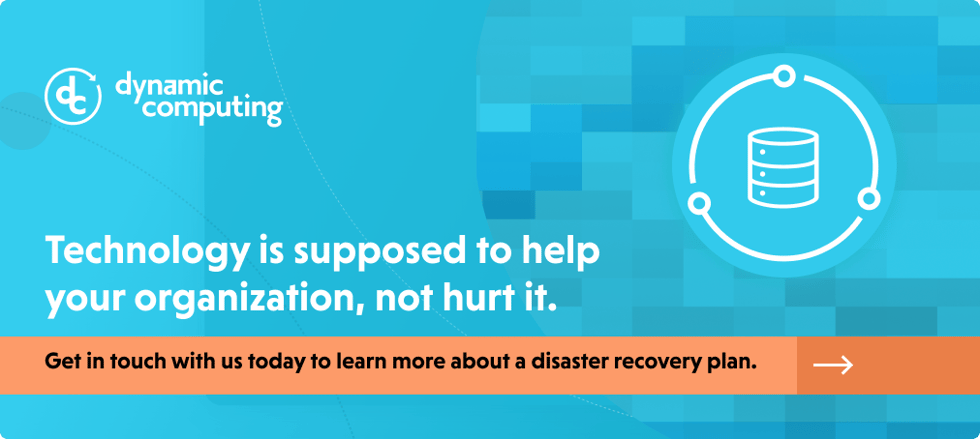The term “disaster recovery” is a bit misleading.
Yes, it refers to your ability to recover from a natural or man-made calamity, but in IT, the term is actually used to describe two things: how you back up your data and applications and the plan you have in place to recover quickly should a disaster occur.
Every business, small or large, needs to have disaster recovery measures in place. Without it you risk:
- Disrupting your business continuity, which can lead to heavy financial losses and potentially irreparable damage to your company’s reputation
- Losing data, which not only prohibits you from recovering quickly from an event but risks running afoul of compliance and legal requirements
- Erasing customer trust and confidence in both your company and its products
So how do you develop and implement a solid disaster recovery plan? While the measures you ultimately put in place will vary depending upon your company’s unique needs, the first — and arguably most important — step is to ensure everything is properly backed up.

Building in redundancies
Most of us now utilize some form of backups in our daily lives. Photos on our phones that also live in the cloud, for example, or tax filings that exist both digitally and in physical copies.
In IT, backups generally have three components: devices, internal infrastructure, and cloud platforms.
There are devices — laptops, desktops, phones — where specific data folders can be automatically backed up via services, like Microsoft 365 or Dropbox, and applications and settings via other platforms.
Things get a bit more complicated with internal infrastructure like servers, where best IT practices now involve both a physical backup — another server that can quickly be switched on should the primary one fail — and a backup in the cloud.
Lastly, there’s the backup of your information stored in your company’s cloud platforms, and it’s here that companies often run into their biggest challenges.
Contrary to what you may assume, the cloud is not a vault where you can store your data and applications and then forget about them. The major cloud providers only retain deleted files for 30-120 days, and while this isn’t an issue when things are running smoothly and backups are happening regularly, that’s not always the case.
For example, say a disgruntled employee decides to delete some files on their way out the door. A lot of the time, the damage they’ve intentionally done isn’t discovered until months later, meaning any attempt you make to restore those files from your cloud backup will be a dead end.
Scenarios like this are why it’s important to have a third-party backup of your cloud data.
For our clients, we deploy a backup system that automatically duplicates the client’s data from platforms like Microsoft 365 and deposits it into a third-party cloud platform that can’t be accessed by unauthorized employees.
In addition, we always ensure geo redundancy in backups of servers and workstations that are separate from the client’s main cloud. That way, should the major earthquake we’re all expecting to hit the Pacific Northwest actually arrive, the client has a backup in a different region — Arizona, for example — that can be used to restore everything from that region or our own local datacenter.

Making your disaster recovery plan
Once you have your backups buttoned down, it’s time to focus on your actual plan for recovery.
Since there are a wide range of potential cyber disasters — everything from ransomware and targeted hacking to natural events and foreign conflicts — it’s important to develop a plan that is flexible, beginning with:
- Identifying potential threats and vulnerabilities and evaluating their impact on your organization
- Determining the critical systems and processes that must be prioritized for recovery
- Developing a comprehensive disaster recovery strategy that outlines the steps needed to restore operations
- Allocating the necessary resources, including personnel, technology, and budget to implement the plan
- Documenting the disaster recovery plan in detail and ensuring that it is accessible and understandable to all stakeholders
Once all of these steps have been completed, it’s time for the implementation stage. This, again, is a process that includes steps like:
- Educating employees and stakeholders about the disaster recovery plan and their roles and responsibilities
- Deploying the necessary technology solutions like your backups and cyber security measures
- Conducting regular tests and simulations to ensure that the plan works as intended and to make any necessary adjustments
- Consistently monitoring and updating your disaster recovery plan to address new threats and changes in the business environment
Get disaster recovery in place now
The very nature of disasters is that you rarely see them coming. The root of their cause may be known, but actually knowing when one will happen is all but impossible to predict.
Because of this, even those small to mid-sized businesses that lack the time and resources to fully develop and implement a disaster recovery plan need to get started on one ASAP.
That’s where a managed IT services provider can help.
If you need assistance with disaster recovery, or already have plans in place but want to ensure they’ll be effective, schedule some time to talk with us.


